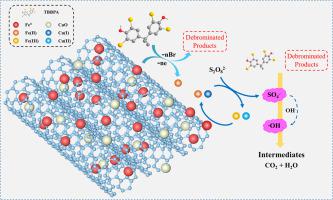Journal of Hazardous Materials ( IF 13.6 ) Pub Date : 2021-05-05 , DOI: 10.1016/j.jhazmat.2021.126029 Zhongting Rao 1 , Nengwu Zhu 2 , Xiaorong Wei 1 , Fei Li 1 , Pingxiao Wu 2 , Zhi Dang 3 , Bofan Cui 1

|
Peroxydisulfate (PDS) is a promising oxidant for sulfate radical based advanced oxidation processes (SAOPs), however its efficient activation is still a challenge. In this study, biochar-supported nano-zerovalent iron (nZVI) and copper oxide (CuO) nanocomposite (nZVI/CuO@BC), derived from low-cost wastes including scrap iron filings, copper leaching solution and corn stalks, was successfully fabricated for PDS activation to enhance tetrabromobisphenol A (TBBPA) degradation in alkaline environment. Under the conditions of 100 mg/L nZVI/CuO@BC, 0.2 mM PDS, pH 8.0 and 25 °C, 86.32% of PDS was activated and 98.46% of TBBPA was degraded within 45 min in nZVI/CuO@BC-activated PDS system. When the PDS concentration was 2 mM, the nZVI/CuO@BC-activated PDS system realized efficient debromination and mineralization of TBBPA at the ratio of 79.12% and 79.36%, respectively. The results of EPR studies and radical scavenger experiments revealed that both hydroxyl radical (·OH) and sulfate radical (SO4·-) were responsible for TBBPA degradation. The nZVI could active PDS indirectly through electron transfer mechanism and exhibited synergistic effects with CuO on PDS activation. Furthermore, the nZVI/CuO@BC-activated PDS system showed good potential to degrade TBBPA in real water environment. Therefore, nZVI/CuO@BC could be a novel strategy for efficient PDS activation and TBBPA degradation in alkaline environment.
中文翻译:

废料中的nZVI / CuO @ BC纳米复合材料对过氧二硫酸盐的有效活化,可在碱性环境中降解四溴双酚A
过氧二硫酸盐(PDS)是基于硫酸根的高级氧化工艺(SAOP)的有前途的氧化剂,但是其有效活化仍然是一个挑战。在这项研究中,成功地制造了由低成本废料(包括废铁屑,铜浸出液和玉米秸秆)衍生的生物炭支撑的纳米零价铁(nZVI)和氧化铜(CuO)纳米复合材料(nZVI / CuO @ BC)。用于PDS活化以增强碱性环境中的四溴双酚A(TBBPA)降解。在100 mg / L nZVI / CuO @ BC,0.2 mM PDS,pH 8.0和25°C的条件下,nZVI / CuO @ BC活化的PDS在45分钟内活化了86.32%的PDS,降解了98.46%的TBBPA。系统。当PDS浓度为2 mM时,nZVI / CuO @ BC活化的PDS系统实现了TBBPA的有效脱溴和矿化,比例为79.12%和79.36%,分别。EPR研究和自由基清除剂实验的结果表明,羟基(·OH)和硫酸根(SO4 ·-)是TBBPA降解的原因。nZVI可以通过电子转移机制间接激活PDS,并与CuO协同激活PDS。此外,nZVI / CuO @ BC活化的PDS系统在实际水环境中显示出降解TBBPA的良好潜力。因此,nZVI / CuO @ BC可能是在碱性环境中有效激活PDS和TBBPA降解的新策略。


























 京公网安备 11010802027423号
京公网安备 11010802027423号